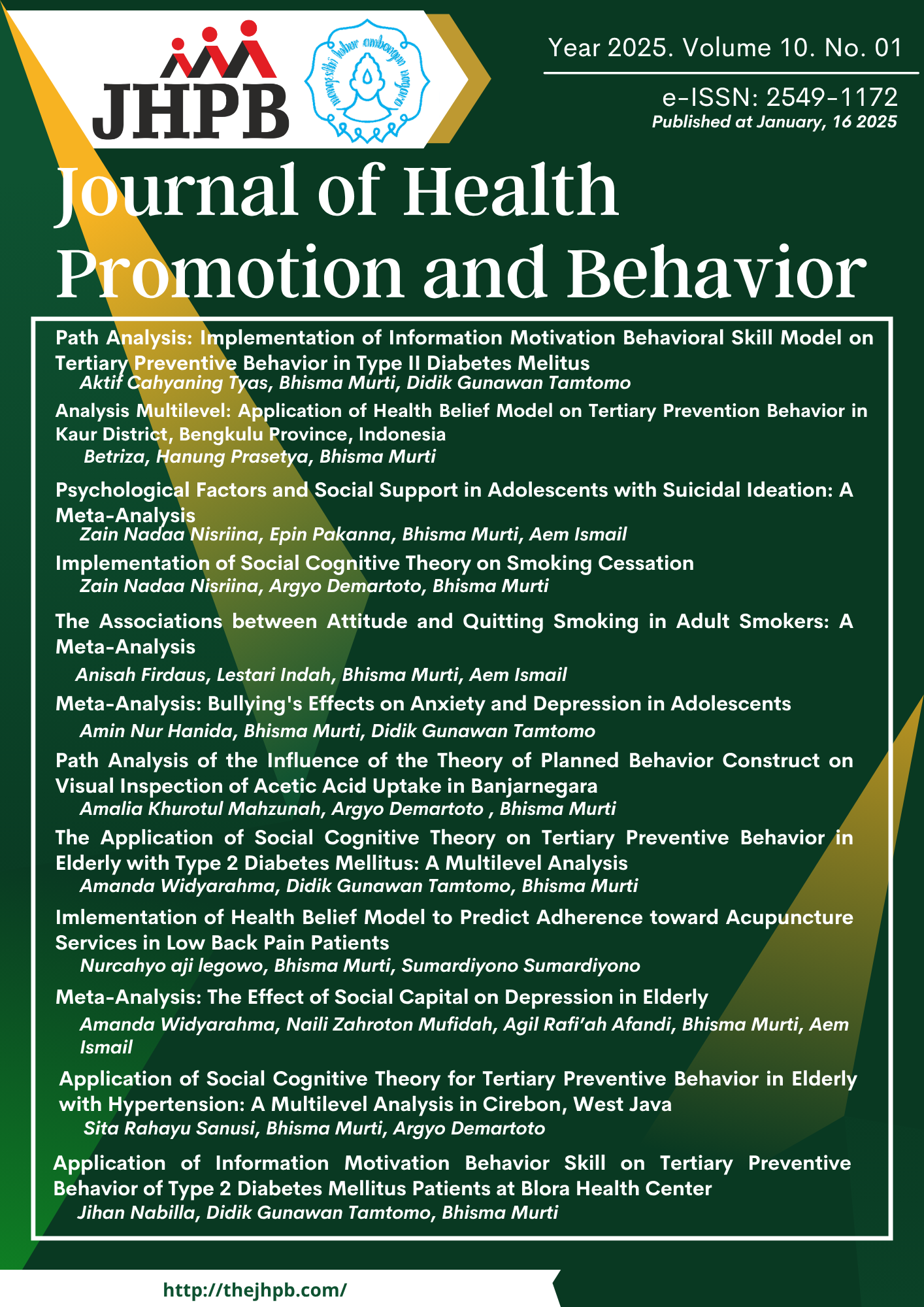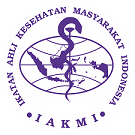Analysis Multilevel: Application of Health Belief Model on Tertiary Prevention Behavior in Kaur District, Bengkulu Province, Indonesia
DOI:
https://doi.org/10.26911/thejhpb.2025.10.01.02Abstract
Background: Uncontrolled hypertension can cause complications, so efforts to prevent and
control hypertension can be carried out by applying the Health Belief Model health promotion
theory. This study aimed to determine the influence of the Health Belief Model construct on
tertiary prevention behavior in hypertensive patients.
Subjects and Method: This was a cross-sectional study conducted in 16 health centers in Kaur
district, Bengkulu, from November to December 2023. A total of 208 hypertension patients were
selected by simple random sampling. The dependent variable is tertiary prevention behavior.
Independent variables are a number of constructs in the Health Belief Model theory including
perceived susceptibility, stimulus to act, and self-efficacy. Data collection was carried out using
questionnaires and data were analyzed using a multilevel double linear regression analysis model.
Results: There was a positive association between perception of vulnerability (b= 0.11; CI 95%=
0.01 to 0.22; p= 0.065), signal to act (b= 0.20; CI 95%= 0.03 to 0.38; p= 0.022), self-efficacy (b=
0.16; CI 95%= -0.01 to 0.32; p= 0.059) on hypertension tertiary prevention behavior. Public health
center have less contextual influence on tertiary prevention behavior in hypertensive patients
(ICC= 6.68%).
Conclusion: Perception of vulnerability, cues to act, and self-efficacy are predictors of
hypertension tertiary prevention behaviors.
Keywords:
health belief model, hypertension, tertiary prevention behaviorsHow to Cite
References
Anita B, Febriawati H and Yandrizal Y (2016), The role of public health cen-ters (puskesmas) as the gatekeeper of national health insurance, J Kesmas, 12(1): 76–89, doi: 10.15294/ kemas.-v12i1.3933.
Apriliani ED, Prasetya H, Murti B (2022), Meta-analysis: Application of health belief model on the adherence to anti-hypertensive medication, J Health Promot. Behav. 7(3): 238–249, doi: 10.26911/ thejhpb. 2022.07.03.06.
Bhattacharya S, Varshney S, Hossain MM, Saleem, SM, Gupta P, Singh A (2023). Taste modification strategy for pre-vention and control of hypertension in India: need for robust clinical trials, Lancet Reg Health, 14(5): 100-206, doi: 10.1016/j.lansea.2023.100206.
Dinkes Kabupaten Kaur (2021). Profil Kesehatan Kabupaten Kaur Tahun 2020 (Kaur Regency Health Profile in 2020). Bintuhan: Dinas Kesehatan Kabupaten Kaur.
Dinkes Kabupaten Kaur (2022). Profil Kese-hatan Kabupaten Kaur Tahun 2021 (Kaur Regency Health Profile in 2021). Bintuhan: Dinas Kesehatan Kabupaten Kaur.
Dinkes Kabupaten Kaur (2023). Profil Kesehatan Kabupaten Kaur Tahun 2022 (Kaur Regency Health Profile in 2022). Bintuhan: Dinas Kesehatan Kabupaten Kaur.
Dinkes Provinsi Bengkulu (2021). Profil Kesehatan Provinsi Bengkulu Kaur Tahun 2020. Bengkulu: Dinas Kese-hatan Provinsi Bengkulu.
Dinkes Provinsi Bengkulu (2022). Profil Kesehatan Provinsi Bengkulu Kaur Tahun 2021 (Bengkulu Kaur Province Health Profile in 2021). Bengkulu: Dinas Kesehatan Provinsi Bengkulu.
Dinkes Provinsi Bengkulu (2023). Profil Kesehatan Provinsi Bengkulu Kaur Tahun 2022. Bengkulu: Dinas Kese-hatan Provinsi Bengkulu.
Dukunde A, Ntaganda JM, Kasozi J, Nzabanita J (2023). Prediction of the prevalence of hypertension and asso-ciated risk factors in rwanda using gibbs sampling method, diseases, 11(2): 87, doi: 10.3390/ diseases110-20087.
Istiana D, Purqoti DNS, Musmuliadin M, Rispawati BH, Romadhonika F, Dingle K (2022). The relationship between physical activity and the inci-dence of hypertension at the work area of the ampenan health center, strada J Ilmiah Kesehatan, 11(1): 45–50, doi: 10.30994/sjik.v11i1.884.
Kementrian Kesehatan Republik Indonesia (2019). Laporan nasioanal riskesdas 2018 (National riskesdas report 2018). Lembaga penerbit Badan Penelitian dan Pengembangan Kesehatan.
Kementrian Kesehatan Republik Indonesia (2019). P2PTM Lembaga penerbit Badan Penelitian dan Pengembangan Kesehatan (P2PTM Issuing institution of the Health Research and Develop-ment Agency).
Ma C (2018). An investigation of factors influencing self-care behaviors in young and middle-aged adults with hypertension based on a health belief model, Heart and Lung, Elsevier Inc. 47 (2): 136-141, doi: 10.1016 /j.hrtlng. 2017. 12.001.
Murti B (2018). Desain dan ukuran sampel untuk penelitian kuantitatif dan kuali-tatif dibidang kesehatan (Design and sample size for quantitative and qualitative research in the health sector). Yogyakarta : Gajah mada Universitas Pres.
Puspita RC, Tamtomo D, Indarto D (2017), Health belief model for the analysis of factors affecting hypertension preven-tive behavior among adolescents in Surakarta, J Health Promotion Beha-vior, 2(2): 183–196, doi: 10.26911/ thejhpb .2017.02.02.08.
Setiyaningsih R, Tamtomo D, Suryani N (2016). Health belief model: deter-minant sofhypertension prevention behaviorinadults at community health center, Sukoharjo, Centraljava, J Health Promot. Behav, 1(3): 160-170, Doi:10.26911/thejhpb. 2016.01.03.03.
Sukohar A (2021). Health belief model and hypertension prevention, Indian. J Forensic Med Toxicol 15(3): 2054–2059, doi:10.37506/ ijfmt.v15i3.15619.
Triyanto E (2014), Pelayanan keperawatan bagi penderita hipertensi secara ter-padu (Nursing services for hyperten-sion patients). Graha ilmu. Yogyakarta
Yanti DE, Perdana AA. Rina NO (2020), Health Belief Model: Selfcare Pen-derita Hipertensi di Wilayah Kerja UPT Puskesmas Kalirejo Kabupaten Pesawaran, J Kesmas, 9 (2): 192–205, doi: 10.33024/jdk.v9i2.2956.
Yue Z, Li C, Weilin Q and Bin W (2015), Application of the health belief model to improve the understanding of anti-hypertensive medication adherence among Chinese patients, Patient Edu-cation and Counseling, Elsevier Ireland Ltd, 98(5): 669–673, Doi:10.-1016/j.pec.2015.02.007.





